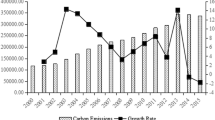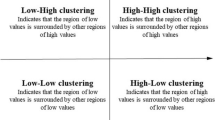Abstract
China is now the world’s largest energy consumer, but severe air pollution problems have brought greater pressure to the production and development of its domestic economy. As an unavoidable result of air pollution, PM2.5 emissions are increasing. Previous literature has focused more on the impact of PM2.5 on the micro-level such as resident health and company location, yet macro-pattern studies between PM2.5 and innovation are inadequate. To bridge this gap, our research uses a spatial dynamic panel data model to systematically investigate the internal and external effects of PM2.5 concentration on innovation in China during the period 2001–2016. After forming a dataset of real-time PM2.5 concentration from satellite detection and using an innovation index instead of patents, we find a stronger spatial linkage between PM2.5 concentration and innovation. Thus, PM2.5 inhibits regional innovation significantly, and this result still exists after using the air mobility index as an instrument variable to alleviate endogenous problems. Lastly, PM2.5 concentration in neighboring regions also impedes local innovation considerably, indicating a spatial ripple effect of PM2.5.


Similar content being viewed by others
Data availability
Data available from the authors upon request.
References
Acs ZJ, Audretsch DB, Lehmann EE (2013) The knowledge spillover theory of entrepreneurship. Small Bus Econ 41(4):757–774
Apergis N, Gangopadhyay P (2020) The asymmetric relationships between pollution, energy use and oil prices in Vietnam: some behavioural implications for energy policy-making. Energy Policy 140:111430
Boschma R, Minondo A, Navarro M (2013) The emergence of new industries at the regional level in Spain: a proximity approach based on product relatedness. Econ Geogr 89(1):29–51
Chalbot MG, Jones TA, Kavouras IG (2014) Trends of non-accidental, cardiovascular, stroke and lung cancer mortality in Arkansas are associated with ambient PM2.5 reductions. Int J Environ Res Public Health 11:7442–7455
Chen Y, Lee CC (2020) Does technological innovation reduce CO2 emissions? Cross-country evidence. J Clean Prod 263:121550
Chen L, Gao S, Zhang H, Sun Y, Ma Z, Vedal S, Mao J, Bai Z (2018) Spatiotemporal modeling of PM2.5 concentrations at the national scale combining land use regression and Bayesian maximum entropy in China. Environ Int 116:300–307
Cheng S, Lu K, Liu W, Xiao DE (2019) Efficiency and marginal abatement cost of PM2.5 in China: a parametric approach. J Clean Prod 235:57–68
Ding Y, Zhang M, Qian X, Li C, Chen S, Wang W (2019) Using the geographical detector technique to explore the impact of socioeconomic factors on PM2.5 concentrations in China. J Clean Prod 211:1480–1490
Greenstone M, Hanna R (2014) Environmental regulations, air and water pollution, and infant mortality in India. Am Econ Rev 104(10):38–72
Hao Y, Liu YM (2016) The influential factors of urban PM2.5 concentrations in China: a spatial econometric analysis. J Clean Prod 112:1443–1453
Hering L, Poncet S (2014) Environmental policy and exports: evidence from Chinese cities. J Environ Econ Manag 68(2):296–318
Hsieh MF, Lee CC (2020) Bank liquidity creation, regulations, and credit risk. Asia Pac J Financ Stud 49:368–409
Hu M, Li R, You W, Liu Y, Lee CC (2020) Spatiotemporal evolution of decoupling and driving forces of carbon dioxide emissions to economic growth along the Belt and Road Countries. J Clean Prod 277:123272
Ji G, Tian L, Zhao J (2019) Detecting spatiotemporal dynamics of PM2.5 emission data in China using DMSP-OLS nighttime stable light data. J Clean Prod 209(2):363–370
Le Sage J, Pace RK (2009) Introduction to spatial econometrics. Chapman and Hall/CRC, New York, NY
Lee CC, Hsieh MF (2013) The impact of bank capital on profitability and risk in Asian banking. J Int Money Financ 32:251–281
Lee CC, Lee CC (2019) Oil price shocks and Chinese banking performance: do country risks matter? Energy Econ 77:46–53
Lin S, Xiao L, Wang X (2021) Does air pollution hinder technological innovation in China? A perspective of innovation value chain. J Clean Prod 278:23–32
Liu K, Lin B (2019) Research on influencing factors of environmental pollution in China: a spatial econometric analysis. J Clean Prod 206:356–364
Liu P, Dong D, Wang Z (2020) The impact of air pollution on R&D input and output in China. Sci Total Environ 752:3–14
Ma J, Ding Y, Cheng JCP (2019) A temporal-spatial interpolation and extrapolation method based on geographic long short-term memory neural network for PM2.5. J Clean Prod 237:11–29
Madrigano J, Kloog I, Goldberg R, Coull BA, Mittleman MA, Schwartz J (2013) Long-term exposure to PM2.5 and incidence of acute myocardial infarction. Environ Health Percept 121:192–196
Payne JE, Apergis N (2020) Convergence of per capita carbon dioxide emissions among developing countries: evidence from stochastic and club convergence tests. Environ Sci Pollut Res 27:1–13
Peters FS, Wagner AF (2014) The executive turnover risk premium. J Financ 69(4):1529–1563
Rohde RA, Muller RA (2015) Air pollution in China: mapping of concentrations and Sources. Scopus Prev 10:1–14
Shuai C, Shen L, Jiao L, Wu Y, Tan Y (2017) Identifying key impact factors on carbon emission: evidences from panel and time-series data of 125 countries from 1990 to 2011. Appl Energy 187:310–325
Sofowote UM, Su Y, Dabek-Zlotorzynska E, Rastogi AK, Brook J, Hopke PK (2015) Constraining the factor analytical solutions obtained from multiple-year receptor modeling of ambient PM2.5 data from five speciation sites in Ontario, Canada. Atmos Environ 108:151–157
Sun JJ, Liang MJ, Shi ZH, Shen FZ, Li JY, Huang L, Ge XL, Chen Q, Sun YL, Zhang YL, Chang YH, Ji DS, Ying Q, Zhang HL, Kota H, Hu JL (2019) Investigating the PM2.5 mass concentration growth processes during 2013-2016 in Beijing and Shanghai. Chemosphere 221:452–463
Tao J, Ho CY, Luo S, Sheng Y (2019) Agglomeration economies in creative industries. Reg Sci Urban Econ 77(1):141–154
Tie X, Long X, Dai W, Brasseur GP (2017) Surface atmospheric PM2.5 optical, satellite distribution depth and of related effects on crop production in China. Air Poll East Asia: An Integr Perspect 16:479–488
Wang X, TianG YD, Zhang W, Lu D, Liu Z (2018) Responses of PM2.5 pollution to urbanization in China. Energy Policy 123:602–611
Wei Y, Gu J, Wang H (2018) Uncovering the culprits of air pollution: evidence from China’s economic sectors and regional heterogeneities. J Clean Prod 171(2):1481–1493
Wen H, Lee CC (2020) Impact of fiscal decentralization on firm environmental performance: evidence from a county-level fiscal reform in China. Environ Sci Pollut Res 27:36147–36159
Yang G, Huang J, Li X (2018) Mining sequential patterns of PM2.5 pollution in three zones in China. J Clean Prod 170:388–398
Yu J, Jong RD, Lee LF (2012) Estimation for spatial dynamic panel data with fixed effects: the case of spatial co—integration. J Econ 167(1):16–37
Yuan H, Feng Y, Lee CC, Chen Y (2020) How does manufacturing agglomeration affect green economic efficiency? Energy Econ 92:104944
Zeng J, Liu T, Feiock R, Li F (2019) The impacts of China’s provincial energy policies on major air pollutants: a spatial econometric analysis. Energy Policy 132:392–403
Zhang Y, Li X, Nie T, Qi J, Chen J, Wu Q (2018) Source apportionment of PM2.5 pollution in the central six districts of Beijing, China. J Clean Prod 174:661–669
Zhang Y, Shuai C, Bian J (2019) Socioeconomic factors of PM2.5 concentrations in 152 Chinese cities: decomposition analysis using LMDI. J Clean Prod 218(5):96–107
Zhu C, Zhao D, Qiu Z (2019) Internal and external effect of estate investment upon regional innovation in China. Emerg Mark Financ Trade 55(3):513–530
Zhu Y, Wang Z, Yang J, Zhu L (2020) Does renewable energy technological innovation control China’s air pollution? A spatial analysis. J Clean Prod 250:1–13
Acknowledgments
The authors are grateful to the comments and suggestions from the Editor and two anonymous referees.
Funding
The research has been financially supported by the Project of the National Natural Science Youth Foundation of China (Grant No. 72003055), Project of Humanities and Social Science Research Youth Fund of the Ministry of Education (Grant No. 20YJC790195), Special Project of Philosophy and Social Sciences of Anhui Province (Grant No. AHSKC2019D05), the Fundamental Research Funds for the Central Universities (Grant No. JS2020HGXJ0035, No. JZ2020HGQA0179, No. JZ2018HGBZ0185, No. JS2019HGXJ0023), and Natural Science Foundation of Jiangxi Province of China (Grant No. 20202BAB201006).
Author information
Authors and Affiliations
Contributions
All authors contributed equally to this study and share first authorship. All authors provided critical feedback and helped shape the research, analysis, and manuscript. Chen Zhu is responsible for conceptualization, investigation, and writing of original draft and analysis; Chien-Chiang Lee is responsible for the supervision, visualization, and writing—reviewing and editing
Corresponding author
Ethics declarations
Ethical approval
This is an original article that did not use other information, which requires ethical approval.
Consent to participate
All authors participated in this article.
Consent to publish
All authors have given consent to the publication of this article.
Competing interests
The authors declare that they have no competing interests.
Additional information
Responsible Editor: Philippe Garrigues
Publisher’s note
Springer Nature remains neutral with regard to jurisdictional claims in published maps and institutional affiliations.
Rights and permissions
About this article
Cite this article
Zhu, C., Lee, CC. The internal and external effects of air pollution on innovation in China. Environ Sci Pollut Res 28, 9462–9474 (2021). https://doi.org/10.1007/s11356-020-11439-y
Received:
Accepted:
Published:
Issue Date:
DOI: https://doi.org/10.1007/s11356-020-11439-y




